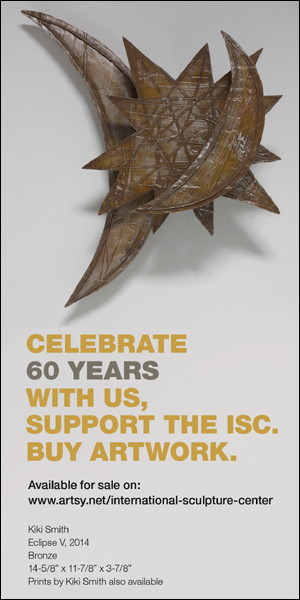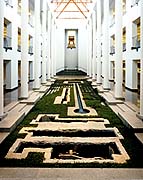
Michael Singerís sculptural works from the 1970s and 1980s opened up new dialogues on approaches to site specificity and the development of public spaces. His more recent works have been recognized for their original solutions to the integration of aesthetic and social preoccupations in the context of public works and infrastructures. These projects exemplify how artistic practice can cross over into and include other disciplines such as design, landscaping, engineering, and architecture. In 1993 The New York Times declared the design of the Recycling Center in Phoenix, co-produced by Michael Singer and Linnea Glatt, to be one of the eight most significant architectural projects in America that year.
A fine arts graduate of Cornell University, Michael Singer has, since 1971, received many prizes and grants, notably from the National Endowment for the Arts and the Guggenheim Foundation. His work can be found in the collections of the Albright-Knox Art Gallery, Buffalo; the Australian National Gallery, Canberra; the Louisiana Museum of Modern Art, Humlebaek, Denmark; the Solomon R. Guggenheim Museum, New York; the Museum of Modern Art, New York; and the Yale University Art Gallery, New Haven.
Among Singerís recent outdoor environmental projects are the two-acre Woodland Garden (1993) for Wellesley College in Massachusetts and the one-mile Waterfront Park restoration master plan project in New Haven, Connecticut, which he directed. In Stuttgart, Germany, he created Ritual Series/Retellings For Those Who Survived (1992), a one-acre commemorative sculpture garden. At the Denver, Colorado, airport he designed a large-scale indoor garden that dramatically transformed the site, and at the Isabella Stewart Gardner Museum in Boston, Singer has revolutionized the notion of exterior museum garden design. He is presently working on a multidisciplinary revitalization project for the Troja Island River basin in Prague; an interpretive center for the Lower East Side Tenement Museum in New York; a restoration policy for the Eldridge Street Synagogue in downtown New York; and an artistsí environment for the Millay Colony for the Arts in Austerlitz, New York.
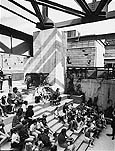
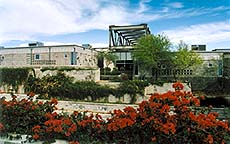
John Grande: In the 1970s you were working predominantly, but not exclusively, in outdoor sites. In your ritual series there is a gradual evolution in your approach to outdoor sculptural composition. Your works from the 1970s go from drawing with trees, bamboo, and phragmites in natural sites to juxtapositions of cut wood and natural wood, cut stone and natural stone, and then the materials start merging. In the mid 1970s, you began working on indoor environmentsóthe “Seven Moon Ritual Series” (ongoing), the “Ritual Gates Series” (ongoing), and so on. Writers commented at the time that these works introduced a human element into environmental sculpture. They were not just about nature, but about habitation, integration, and even fictional histories of habitation. Itís interesting that you did not distance your work from ritual, as so many artists did at the time, and saw this as a compliment to your artistic process of working in nature.
Michael Singer: Yes, because I saw my everyday work in these environments and my studio as the daily rituals resulting, eventually, in a work of art. At the time I felt I could keep making outdoor installations in beautiful environments forever. Itís seductive. In the “Lily Pond Ritual Series,” (1975) I sought to build a structure that captured light in different ways at different times: late afternoon, early morning, and so on. I wanted to create works where the human activity wouldnít be destructive and yet would interface with the natural environment. Eventually the question became, “What happens with a site that doesnít have reflection, illusion, changing atmospheres of light and space?” This led me to a site in an old hemlock forest, a dark place in the woods. I took the limbs off old hemlocks and first built a mat to create a level place. I felt that this might be the intervention a human being would undertake in such an environment. It became a starting point for other ideas. I then built the perimeter walls and the work became a container for the other ideas.
Grande: I find your piece Ritual Series (1980ñ81), in the Guggenheim, fascinating. Here is a sculpture that begins where the outdoor series such as the “Lily Pond Ritual Series” left off. The piece is really conceived for space, rather than a specific indoor or outdoor setting. Yet because your art is as much about the way humans interact with nature as it is about nature itself, the work becomes almost mythopoetic. You put together a structure from the wood of an old barn and built a base. Itís like art as archaeology órecovering the history of a site and reinvesting it with a new meaning through reconfiguration. There are also storage shelves in the structures with stones. This makes one reflect on our fixation with object-meaning in art, as much as the space this installation is in. The subject seems to be the way we perceive structures materially and material structurally.

Singer: Itís a question of what happens when you take an idea from a natural environment and work inside architecture. The base of Ritual Series is the wooden floor of a barn that has been taken apart and reconfigured. I made walls similar to the hemlock forest piece and built the structure within it. Itís a kind of intervention that builds its meaning into an architectural setting.
Grande: The early pieces are fragile structures, everything hangs on everything elseóthe language of forms and natural forms and precut wood and stone. This interrelation of many formsóboth man-made and naturalócast you as a neo-primitive back in the 1970s, yet, as with the vast indoor garden at Denver International Airport, which adds mystery to an otherwise dull functional building, or your first permanent work in a building in 1986, the meaning of the place is located by your work. You donít play off the structure, but you center it by adding another layer of meaning to the architecture. It is less decorative or additive than geocentric in approach.
Singer: Yes. In the case of my first permanent project I really respected the architect, Michael McKinnell, and he asked me to design two large atrium spaces in the building. These are spaces that visitors look into. When it was completed, the architect actually told me: “We designed the space and you transformed it into a place.” At the Denver airport, the garden is visible from the level above where thereís a McDonaldís restaurant and all the airport junk stores. The garden is covered with vines, ferns, all manner of growthóa living ecology, and a complete contradiction to its surroundings.
Grande: You transform the whole meaning of architectural siting, bringing a kind of mystery to the place that would otherwise be lacking. Yet in your works, it is as much this aspect of play, where non-linear growth elements intersperse with linear puzzles and syntaxes, that are not absolutely resolved. They are puzzles with clues about the way nature designs holistically and the way we design rationally. The language you use is one that informs, even educates, the viewer to the way we actually look, the way we perceive nature and the built environment in different contexts.
Singer: I am involved in investigations of, for instance, the intersection of the built and natural environment. Then the issues of geology, of time, and of layers enter more strongly into the subtext. Slate, granite, and natural stone become materials that inform us as to the built realm as well as the non-built. Architecturally I am interested in how people move through a space and how architecture choreographs our movement through space, as well as the power architecture has in bringing meaning to a site.
Grande: Your work references historyóboth human and naturalóand it builds links both in the materials you use and in the alliterative forms you create. Sometimes I feel they are akin to Shinto ritual sculpture, as in a 1986 intervention titled “Sangam Ritual Series” (sangam is a Hindu word describing the place where two rivers join) in Aspen, Colorado. There is a miniature element of the piece within the walls and gates you built. Itís like a micro-comment on the macro-scale of our landscape perception. Itís a shrine to nature and the material allusions also allude to the underlying geology with its series of steps and layers.
Singer: Aspen was the first time I worked in a site that I felt needed alteration. The river winds around at almost a right angle where I began. After working for 15 years in outdoor sites where I didnít touch anything, the “Sangam Ritual Series” was the first time I actually manipulated the site itself. It began to be about building a garden. I felt the need to establish a portal and boundary for the site. As visitors enter through the portal, the sounds of the river become magnified. The small, sunken element within is like a table of contents. And that archaeological thing you are talking about with the layering of stone is the element which becomes a reflection of the layering of the land.
Grande: Thereís a similar sense of the lived-in history of the land in the “Tomol Ritual Series” (1987), created for the redwood section of the Santa Barbara Botanical Garden in Mission Canyon Creek, California.
Singer: You first see it from the top of a canyon by looking down onto a structure built right on the stones of the stream. There are storage areas in it that describe another area of human activityóthe need to create places to keep special things. The title comes from the Chumash Indians, the native culture that lived there. They were the only native people to make planked boats that were not carved out of tree trunks. They had a technology of making planks and using tar from the beaches to seal the planks. They used a rope that they made from vines to tie the planks. They also had a ritualized secret society of the boat called the Tomol. I found some minutes from the last meetings in the 1880s that were translated by a man who learned their language. It was very poignant and I tried to make connections to that culture and relate it to issues of our time.
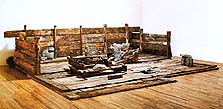
Grande: Your work at the Phoenix Recycling Center (1993) is truly exceptional for an artist. I mean, who would believe that artists created that building, the site, the layout, the daily patterns for movement of goods and vehicles, and the visitorsí locations. Yet apparently it draws crowds of school kids, tourists, and Phoenix citizens, both to see whatís going on and to recycle materials.
Singer: I worked on this project with Linnea Glatt from Dallas. An engineering firm had done a preliminary plan that really defined this place as something no one would ever want to come to. It was a building that was a boxóclosed in on itself, 25 acres of pavement with a nightmare traffic situation for the 500 tractor-trailer sized trucks coming in every day along with other users. People were supposed to bring their recycled materials into the back of the site which was hidden out of sight and therefore out of mind, not even related to the building. Basically, I think the planners thought that the invited artists would do what most artists would do in a public art project. They would choose a color and paint a stripe around the building and make a little something that would be there. We just said thereís no way. There was a lot of money involved here, as a percentage of an $18 million construction project. There was no way that anything they would have done here, if they had maintained the plan, could have humanized this place. It would be like every other off-the-shelf waste facility that is built around the world. Phoenix had a very special public works official, Ron Jensen, who listened when we started to point out some of the real problems of the site, like, for example, that all the visitors and administration for this building were on the east side of a two-acre structure filled with garbage, and the wind blew west to east. So right offóit took an artist to tell them that if they just moved visitors and administrators to the west side, upwind, they would be way ahead of the game. In defense of the engineers, they never even went to the site. They just pushed a button on a computer and out came the design. There were other similar problems that we were able to point out. So Ron Jensen said “OK. We have a facility to build. Itís on a schedule. We can give you two months to come back with a new site plan and letís see what you artists can come up with.” As artists we put together and led a team of professionals who worked with us to question the design, and to redesign the site of this facility. It all happened in that brief time. We told them, “The site plan is one thing, but we should really design the building, we should design every aspect of this site to give it meaning. If you really want people to understand this place and be open to it, it really needs the approach to every element in the site.” And Jensen said “Go for it!” We also increased their program here, adding all kinds of community spaces. The project ended up costing 25 percent less than its original $18 million budgetó$13 million.
Grande: So there was a switch from environmental artist to environmental designer in this process.
Singer: Not a switch but an inclusion, an addition. After 20 years of work in natural environments and questioning my role in a natural environment and what humans do there, I began to wonder how I could use that knowledge to address community issues, to look at problems in communities from an artistís point of view. I began to develop a sense that the creative process of artists is very special, and different than any of the other professionals. Itís not that we have the solutions, sometimes we will, but we have observations, questions, and ideas, and we should be invited to the table to talk about the problems and to help with the problem-solving. That is what is happening in addition to what I was doing before.
Grande: Working on percent-for-art projects is something of a dilemma for the artist. Artists have to respond to designs that are already decided. There is seldom much communication between the landscaper, the architect, the artist, and the public works department.
Singer: Percent-for-art work tends to become decorative and tacked on rather than worked on in consultation with landscapers or architects. People come to the Phoenix project and say, “Well where is the art?” Itís really not there. Itís within the design, itís within the questioning, itís in the raising of new issues.
Grande: Isnít one weakness of art as process, even if it deals with architectural structures and space as Gordon Matta-Clark did, that its final goal is to demonstrate an idea. That was part of the problem with Land Art and Minimalism. A lot of it was extremely wasteful. It could simply be done by drawing on a photo. Whereas your own works build from a context outward. The aesthetic becomes less of a purist notion, even if the forms and materials have pure relations. So, in a sense, it becomes more permanent.
Singer: It isnít just of the moment.
Grande: When you look at Tadashi Kawamataís workóthe large scale works with the wood coming out of buildings and so onóit maintains the mystique of art that has a relation to public life but a dysfunctional one. His work integrates into an environment, but finally it becomes a display that emphasizes the disconnectedness of things, and it is eventually deconstructed. It describes the symptoms without alleviating the problems.
Singer: Those pieces are display, but also part of a dialogue within an exclusive conversation. Artists can respond back and forth in those dialogues. Theyíre a lot of fun. But Iím really interested in more than that.
Grande: It perpetuates a myth of art which doesnít include society or the public directly as participant.
Singer: It happens in every profession.
Grande: It codifies, the same way professional medicine is codified, mystified, put into a language that is inaccessible and complex. Where is the simple holistic vision? We are fed so much encoded professional jargon we often cannot see the forest for the trees.
Singer: Itís a symptom of a whole culture that encourages specialization. What interests me about Pierre E. Leclerc, Michel Archanbault, and their gallery (200m3) is that they really want to go beyond the specialization and encourage cross-disciplinary interest. Itís much more fun. Itís really stimulating and fun for me, to be looking within the same day at issues that deal with planning in Prague, or an interpretive center for the Lower East Side Tenement Museum in New York, or a restoration policy for the Eldridge Street Synagogue in downtown New York, or to ask questions about a sculpture that has been sitting in my studio slowly evolving and being informed by all this other input. This is much more important for me than where my next show will be, who is publishing my work, all of those kind of things. This is what really excites and enriches me.

Grande: Part of the challenge, really, is to build some kind of holistic culture where people consider themselves all part of a community, and they put their energies together rather than being divided by professionalism.
Singer: Itís very important for me to acknowledge that even though Iím working on so many projects, it isnít me alone in my studio. Iím working in the community, putting together people in projects, some of whom have never worked on projects. Iím interested in a cultural historianís perspective on something, or an anthropologistís, an architectís, or an engineerís.
Grande: In a sense, everything is inversed. There are limitations to object-based analysis in criticism, to theoretical discourse; there are limits to everything, but if you can establish some linkages that havenít existed before, then things are moving forward, which I think your work does quite well. Prototypes are always good in art, but itís the transferal from prototype to real life that is the challenge I think youíre meeting.
Singer: Phoenix is a good example. Remember that, in 1989, no architect would consider designing a waste facility. It took artists to change this. I think this is an example of what artists do: an artist being given a problem will come up with new ideas and questions. Some of them will be ridiculous and some of them will offer unthought-of possibilities. In 1989 it could probably have been thought of as ridiculous that a waste facility was a design opportunity, a place for the public, but this has now changed.
John Grande is a Montreal-based writer on the arts who has contributed to Artforum, Sculpture, Art Papers, On Paper, The Structurist, Vie des Arts, Espace, and Canadian Art. He has authored several books on contemporary art including Balance: Art and Nature (Black Rose Books, 1994) and Intertwining: Landscape, Technology, Issues, Artists (Black Rose Books, April 1998).



